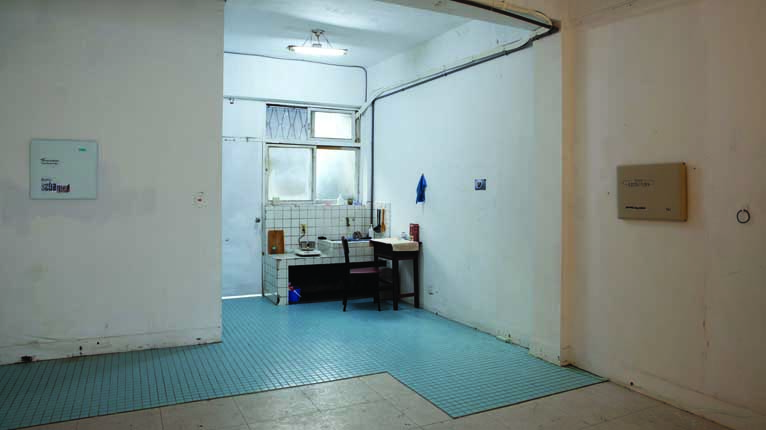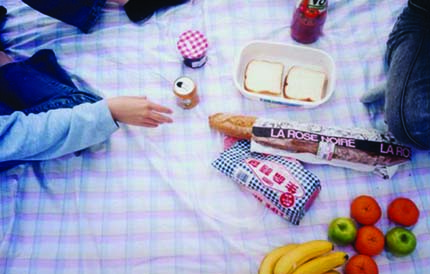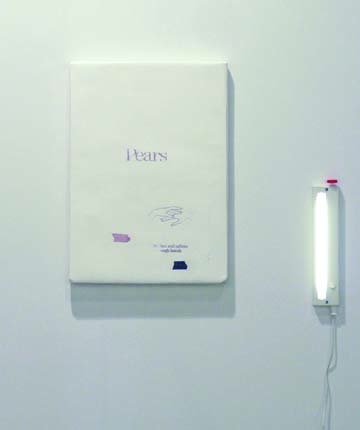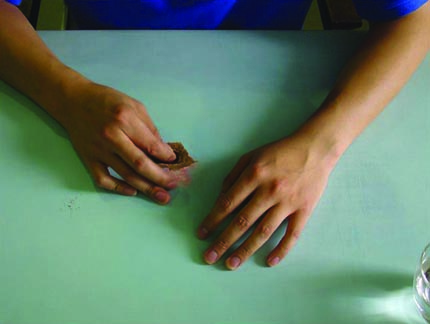LEE KIT: A SLICE OF LIFE
| July 9, 2012 | Post In LEAP 15

It would be easy to view the artistic practice of Lee Kit as a quaint celebration of the quotidian side of life, or perhaps as a pensive homage to the everyday carried out through a mute interplay of found objects placed within a space. In this sense it resembles so much global arte povera seen today: everyday objects or understated materials employed in ways that emphasize their mundane qualities or exude an economy of form enhanced by careful arrangement against pristine— or not so pristine— gallery walls. Such practices tend to be viewed either reductively as attempting to dissolve the boundaries between art and life or, in exaggerated circumstances, are assigned automatic political or social valence just by virtue of the fact that they deal with the realm of common experience or reflect an artist’s desire to confront realities outside the art world as opposed to confining oneself within it. Conveniently for Lee Kit the art world in Hong Kong is a small place, which means one cannot get too lost in it. But by the same token the smallness can be suffocating; which might account for Lee’s decision to shift more of his time outside Hong Kong. In keeping with his Hong Kong artist counterparts, spectacular and heroic gestures are not a part of Lee’s vocabulary. In fact, Lee may lead the pack in presenting obfuscating installations with personalized origins that come with no immediately discernible concept, agenda or narrative. His offbeat combinations of everyday objects with hand-painted textiles, cardboard paintings and other cheap materials emerge from eminently individual concerns, but they are no less valuable to the dialogue of what it means to be an artist in Hong Kong today.
If one can detect the air of minimalism in Lee’s practice— not only in the scant use of forms and perceived lack of expressive cues but a certain foregrounding of the object’s status or objecthood— you would not be far off. Lee’s pastel-colored fabrics and readymade items are situated in space with a just-so pitch that contemplates relationships to each other as well as to the whole. His pared-down approach and reduction of forms owes much to the principles of abstraction and repetition, not to mention allusions of absence and loss. But reliant upon industrial production methods Lee most definitely is not, nor is he seduced by that period’s sleek, manufactured surfaces and machined aesthetic. The everyday objects Lee fetishisizes are more rightly understood as unassisted readymades and, despite their common origin, for Lee they stand in as touchstones for intensely personal, obscure, and ambiguous moments coupled with private memories and fictional scenarios. Lee arranges his prized possessions in ways that actively avoid any semblance of ordered systems and rational thinking; rather, the objects are used to conjure contextually specific moods or precise moments in time that have grown symbolically loaded with emotional significance.

Lee Kit’s recent works may be weighted towards installations (or “settings” as he prefers to call them) but at his core he is a painter, albeit one that shies away from conventional canvases and representational or figurative imagery. Experimenting with hand-painted textiles as early as 2001 while a student at the Chinese University of Hong Kong, Lee soon experienced a transition whereby his flat, previously wall-hung paintings consisting of striped patterns became transformed into functional objects that could be utilized and handled on a daily basis. The defining episode for this change was a picnic during the aftermath of the SARS epidemic in 2003 when— after many weeks of government-encouraged indoor seclusion— he and some friends took the bold step of holding an outdoor picnic. One of his cloth paintings played an impromptu role as a picnic spread, leading to the work Sunday Afternoon: Picnic With Friends And Hand-Painted Cloth At Yung Shu O, Sai Kung (2003). From that period on, Lee’s painted fabrics doubled as cloths he could use to wash windows, to wipe down his studio, or as table coverings during random social gatherings. The resulting works and photographic documentation of people eating, drinking and socializing upon his painted cloths, however, should not lead us to interpret these events as belonging to the category of “relational art.” Lee is not particularly concerned with strengthening or materializing the bonds of social relations nor does he view his fabrics essential to adding up to a certain kind of “experience.” Rather these events and the resulting works belong to the province of randomness and chance. The cloths themselves— far from being instigators to a process— act as silent witnesses to moments of ordinariness where nothing happens and where nothing in particular is said.
One of Lee’s cloths even made its way into the annual July 1 protests in Hong Kong in 2004. Perhaps as a way of registering his disinclination towards the literal, the cloth banner remained characteristically blank, acting as a sort of wordless emblem for his own taciturn self. Far from an accidental gesture, it did offer the artist an indirect way of participating in the street action, even if his position remained a deeply conflicted one bereft of concrete pronouncements. Likening this work to Fluxus or French Situationists’ strategy of “taking art to the streets,” however, would fail to register the crucial point for Lee: inserting his cloth paintings into the public sphere is not a reflection on the nature of art per se, but rather a veiled statement of his own position vis-à-vis the world, that is, an oblique way of admitting he simply might not know what to say. One might venture that what matters to Lee is not the actual gesture or action of making the cloths— though this is also clearly valued— but the attitude towards life that they suggest and the freedoms that they represent. If artistically his hand-painted cloths represent the ability to debauch the rarefied status of the art object (thereby opening up a new realm of possibilities for making art), then politically they come to stand for a certain attitude towards life that finds emancipation in the small details and cracks of everyday life. Reveling in moments of purposelessness and boredom can, for Lee, form an understated counterpoint to the usual forces of productivity and efficiency so prevalent in Hong Kong’s goal-oriented and highly bureaucratic society. To this end, Lee offered “3/4 Suggestion for Better Living,” his breakthrough solo exhibition at Para/Site Art Space, Hong Kong in 2007 that recast the intimate exhibition space as a lively café/bar setting adorned with hand-painted patterned fabrics atop tables and hung on the walls. Guests were welcomed to socialize aimlessly while being served drinks by Lee and his artist friends wearing T-shirts saying “My Favorite Waste of Time.” In addition to enjoying live music and drinks, people were allowed to smoke indoors— a small triumph that Lee used to thumb his nose at the then-recently passed Hong Kong law banning smoking inside bars and restaurants. The show epitomized Lee’s interest to bring a slice of his life into the gallery or exhibition setting and to temporarily address the lack of casual gathering spots for the growing Hong Kong art community.

In recent years Lee has taken to paintings pieces of cardboard in ways that resemble aged packaging materials for commercial products. Lee crafts these works from layers of cardboard that are wrapped around a wooden core and then covered with acrylic or emulsion paint in light candy-colored hues. Afterwards, he applies inkjet transfers of product logos and the occasional bit of tape; scratch marks or other calculated imperfections help to make works such as Johnson’s (Mild and) (2010) or Pears (2011) come across as worn and faded portraits of products from some distant past. In some cases Lee’s fascination with these cosmetics takes an eerie turn, such as with “Sing Any of Them, Sing All of Them” (2009), a set of karaoke-style videos featuring various shots of jars of Nivea and tubes of Vaseline set to schmaltzy music. First exhibited in Osage Soho, Hong Kong, the obsession reached new heights as actual products were displayed like museum artifacts encased in Plexiglas vitrines.
Lee’s cardboard paintings have grown to become a consistent feature of his installation settings. Perched on the wall next to settings including everyday materials and household items, they are a constant reminder of daily rituals and cycles of consumption that permeate contemporary life. Mimicking humdrum domestic spaces such as living rooms, bathrooms, and kitchens, Lee’s installations are works eminently grounded in the interior— which is why, despite their use of flat and three-dimensional forms and an absence of pictorial space, they do not stray as far from the practice of painting as one might think. Lee’s concerted efforts at creating and representing a state of mind or disposition in his installations are contingent upon a degree of illusion, and rely predominantly on pulling the viewer into this realm through retinal rather than other sensory means. Looking at his work it often feels like one is peering into someone’s private space or through a window into Lee’s personal past— but in sense this is precisely the point: the atmosphere Lee creates is both precious and commonplace, highly symbolic and utterly random.
If conceptual art has traditionally placed emphasis upon a concept or idea over its materialization or spatio-temporal presentation, then the work of Lee Kit might be something of an imperfect fit. He perhaps belongs more appropriately to a post-conceptual or even post-minimal designation whereby so-called non-expressive gestures are coupled with bouts of language and non-linear thinking. Lee’s reluctance to verbal articulation echoes that of many painters (“if I could describe and explain what I am doing, then I wouldn’t need to make it”) and resembles a position disliked by hardcore conceptualists who maintain that the work need not be made at all to exist. And yet Lee finds ways to embrace language through his prolix and sometimes zany titles. Borrowing song lyrics from bands as diverse as Spice Girls and Joy Division, the titles introduce a level of poetic framing to what might otherwise appear to be random gatherings of unrelated objects and seemingly insignificant narratives. In some cases he develops narratives based on concrete sources such as song lyrics or found photographs, as in “Well, That’s Just A Chill” (2010), a series of patterned cloths and cardboard paintings that emerged from various found images. Each work’s title— sometimes several lines long— recounts a brief invented story. In other cases, Lee’s installations gravitate towards the arcane, drawing upon an intuitive set of associations and connections that are both logical and oblique at the same time. Take “It’s Not An Easy Thing” (2012)— a title gleaned from a song by Taiwanese singer Tsai Chin— an installation at Arrow Factory (a non-profit space in Beijing that I co-founded with three artists) this past winter as one example of Lee’s circuitous thought process. In a space totaling less than five square meters, Lee carefully arranged an assortment of new and secondhand objects and furniture, taped a poster to the glass and piped Tsai Chin’s syrupy music into the street. The scant installation— meant to evoke a 1980s-era rundown music shop on the eve of a new album release— was inspired by sentiments surrounding the artist’s first visit to Beijing during the dead of winter. Facing a journey from south to north triggered in Lee an array of associations and conflicting emotions: fears about experiencing the acute cold gave way to trepidations about entering the political space of mainland China and being confronted with unresolved feelings about the past. These internal agitations, compounded by his peripheral position as an outsider from Hong Kong, yielded a cryptic memorial with fictional and illogical origins and decidedly political undertones. The installation epitomized Lee’s ongoing effort to reconcile the fragile workings of his inner self with the outward discomforts and injustices he faces in everyday reality.

While Lee’s work may not be of the variety to offer any clear remedy to the various inequities or internal heartaches it addresses, it does suggest ways of locating the personal within the realm of the political simply by looking at how we live our lives on a daily basis. Here we might look to Filling Up An Ashtray (2008) or Scratching the Table Surface (2006-2010) as exemplary demonstrations of just how committed Lee is to championing the banal sphere of monotony and purposeless behavior. Gradually digging a small hole in the surface of a table in his studio by scratching it repeatedly with his finger on and off for various stretches over a period of four years speaks to a strength of resolve as much as it does to epic levels of laziness and boredom. During this same period, he sent postcards to some 300 friends informing them that he was scratching the table surface. Such a concentrated effort at doing nothing— and announcing it to his friends no less— underscores the tension he feels between acting as a productive artist, and one who simply lives out the redundant gaps, trivial spaces and restless moments of one’s daily life. Lee does well to remind us that such moments are increasingly hard to find in today’s— especially Hong Kong’s— industrious, hyper-productive, hyper-connected environment; and that without attention to life’s repetitive banalities, we may lose possibility for the truly unexpected and irrational to occur.


